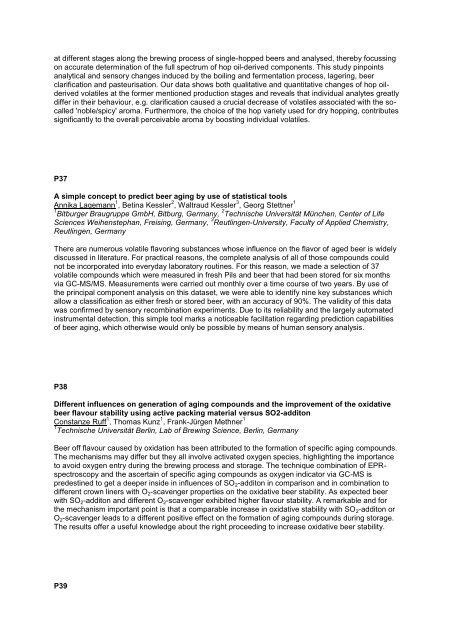here - the 34th European Brewery Convention
here - the 34th European Brewery Convention
here - the 34th European Brewery Convention
You also want an ePaper? Increase the reach of your titles
YUMPU automatically turns print PDFs into web optimized ePapers that Google loves.
at different stages along <strong>the</strong> brewing process of single-hopped beers and analysed, t<strong>here</strong>by focussing<br />
on accurate determination of <strong>the</strong> full spectrum of hop oil-derived components. This study pinpoints<br />
analytical and sensory changes induced by <strong>the</strong> boiling and fermentation process, lagering, beer<br />
clarification and pasteurisation. Our data shows both qualitative and quantitative changes of hop oilderived<br />
volatiles at <strong>the</strong> former mentioned production stages and reveals that individual analytes greatly<br />
differ in <strong>the</strong>ir behaviour, e.g. clarification caused a crucial decrease of volatiles associated with <strong>the</strong> socalled<br />
'noble/spicy' aroma. Fur<strong>the</strong>rmore, <strong>the</strong> choice of <strong>the</strong> hop variety used for dry hopping, contributes<br />
significantly to <strong>the</strong> overall perceivable aroma by boosting individual volatiles.<br />
P37<br />
A simple concept to predict beer aging by use of statistical tools<br />
Annika Lagemann 1 , Betina Kessler 2 , Waltraud Kessler 3 , Georg Stettner 1<br />
1 Bitburger Braugruppe GmbH, Bitburg, Germany, 2 Technische Universität München, Center of Life<br />
Sciences Weihenstephan, Freising, Germany, 3 Reutlingen-University, Faculty of Applied Chemistry,<br />
Reutlingen, Germany<br />
T<strong>here</strong> are numerous volatile flavoring substances whose influence on <strong>the</strong> flavor of aged beer is widely<br />
discussed in literature. For practical reasons, <strong>the</strong> complete analysis of all of those compounds could<br />
not be incorporated into everyday laboratory routines. For this reason, we made a selection of 37<br />
volatile compounds which were measured in fresh Pils and beer that had been stored for six months<br />
via GC-MS/MS. Measurements were carried out monthly over a time course of two years. By use of<br />
<strong>the</strong> principal component analysis on this dataset, we were able to identify nine key substances which<br />
allow a classification as ei<strong>the</strong>r fresh or stored beer, with an accuracy of 90%. The validity of this data<br />
was confirmed by sensory recombination experiments. Due to its reliability and <strong>the</strong> largely automated<br />
instrumental detection, this simple tool marks a noticeable facilitation regarding prediction capabilities<br />
of beer aging, which o<strong>the</strong>rwise would only be possible by means of human sensory analysis.<br />
P38<br />
Different influences on generation of aging compounds and <strong>the</strong> improvement of <strong>the</strong> oxidative<br />
beer flavour stability using active packing material versus SO2-additon<br />
Constanze Ruff 1 , Thomas Kunz 1 , Frank-Jürgen Methner 1<br />
1 Technische Universität Berlin, Lab of Brewing Science, Berlin, Germany<br />
Beer off flavour caused by oxidation has been attributed to <strong>the</strong> formation of specific aging compounds.<br />
The mechanisms may differ but <strong>the</strong>y all involve activated oxygen species, highlighting <strong>the</strong> importance<br />
to avoid oxygen entry during <strong>the</strong> brewing process and storage. The technique combination of EPRspectroscopy<br />
and <strong>the</strong> ascertain of specific aging compounds as oxygen indicator via GC-MS is<br />
predestined to get a deeper inside in influences of SO 2 -additon in comparison and in combination to<br />
different crown liners with O 2 -scavenger properties on <strong>the</strong> oxidative beer stability. As expected beer<br />
with SO 2 -additon and different O 2 -scavenger exhibited higher flavour stability. A remarkable and for<br />
<strong>the</strong> mechanism important point is that a comparable increase in oxidative stability with SO 2 -additon or<br />
O 2 -scavenger leads to a different positive effect on <strong>the</strong> formation of aging compounds during storage.<br />
The results offer a useful knowledge about <strong>the</strong> right proceeding to increase oxidative beer stability.<br />
P39





